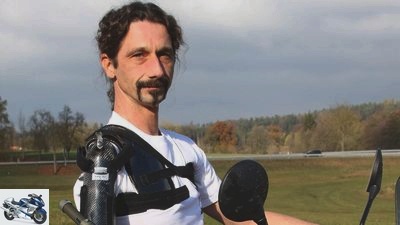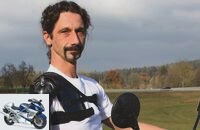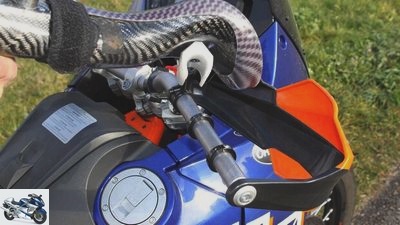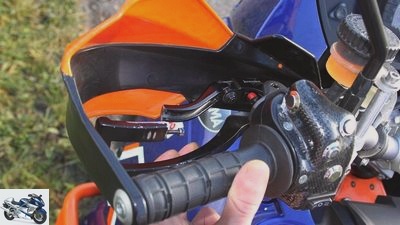Table of contents
- Portrait of Bernd Brand Riding a motorcycle with a prosthesis
- Orthema orthopedic specialists know what to do
- “All self-made”
- TuV passed with flying colors
- Interview with Hartmut Semsch (Managing Director Ortema)

Mayer
Sports & scene
Motorsport
Portrait of Bernd Brand – riding a motorcycle with a prosthesis
Portrait of Bernd Brand
Riding a motorcycle with a prosthesis
The doctors prophesied that after his serious motorcycle accident he would never be able to ride a motorcycle again. But Bernd Brand has long been driving again. Thanks to an irrepressible will and a special prosthesis, not just with the left.
Peter Mayer
02.03.2017
It is September 28th, 2009. For many motorcyclists, the season is slowly coming to an end. Not for Bernd Brand. The then 35-year-old is a thoroughbred biker and only rides a motorcycle. In summer a Kawasaki ZXR 750 with a self-installed 900 engine, in winter a Yamaha XT 600. It happens with the single cylinder. A car driver turns left, overlooking the oncoming motorcyclist. Bernd Brand doesn’t have time to react. The XT hits the side of the car at a 90-degree angle. Fire itself is thrown over the vehicle onto the road. The forearm and shin are broken, the lungs are bruised, and an artery in the right shoulder is torn. The Swabian is transported to the Tubingen Accident Clinic by helicopter. He is quickly recovering from the operations. Only his right arm worries him. Test follows test. On December 12th the final diagnosis: plexus palsy. The nerves responsible for the arm are torn out of the spine. For the rest of his life, Brand will no longer be able to move his right arm willingly.
Buy complete article

Portrait of Bernd Brand
Riding a motorcycle with a prosthesis
2 pages) as PDF
€ 2.00
Buy now
Orthema orthopedic specialists know what to do

Mayer
Click: The prosthesis is clicked onto the handlebar with a plastic part.
“I realized that I would have to live with this handicap in the future. And there were only two alternatives: Either I lie down or get up, ”Bernd remembers that time. He stood up. Learned to work and write with his left hand as a right-hander. To take early retirement in the social hammock was out of the question anyway. Instead, he retrained to mechanical engineering technicians in record time and soon started working in the new job. Thanks to the computer workstation, it can be fully deployed and is independently mobile with an automatic car. Only one dream remained: to ride a motorcycle again. On the Internet, the ex-biker found “a lot of complaining fellow fates, but no solution to my problem,” as he says today. Until he came across the Ortema website. Contact was made quickly. Hartmut Semsch, managing director of the orthopedic specialist based in Markgroningen near Stuttgart, drives a motorcycle himself (see interview below) and has been looking after racing stars from all disciplines for years. “I already felt Bernd Brand’s irrepressible will to be able to ride a motorcycle again during the phone call,” remembers Semsch of the first conversation. The cooperation starts.
“All self-made”

Mayer
Instrument cluster: the brake lever also disengages the clutch when braking.
The orthopedic surgeon made an orthosis, while the mechanical engineering technician converted his new acquisition, a KTM 990 Adventure, for the joint project. The throttle grip (with a different direction of rotation) and the front brake lever moved to the left side of the handlebar, as did the starter button that is now integrated into a carbon housing. The front brake is operated with the index and middle finger, the clutch with the ring finger and the little finger. Smart: the handbrake lever activates the clutch lever, which is lengthened with a screw, when you brake hard. This acts like an anti-hopping clutch and prevents the rear wheel from stamping. Brand proudly sums up “everything self-made”. The fact that he did all of this with his left hand is no longer worth mentioning. Just like the self-made shift assistant. Even if he could have had it easier in this respect. But: “Scooters or automatic motorcycles are out of the question for me,” says the Swabian hardcore biker.
TuV passed with flying colors

Mayer
Home work: The shift assistant on the KTM comes from Bernd Brand’s workshop.
Even when the driver’s license office tries to reduce his driving license to an automatic bike, Brand remains stubborn. He doesn’t even accept the restriction to solo operation. Ultimately, he passed the “suitability report for unrestricted use of the appropriately equipped vehicle” from the TuV with flying colors. Five years after the accident, Bernd Brand is legally allowed to drive a motorcycle on the road for the first time. The orthosis is further optimized and has a spring-loaded cylinder that allows the carbon part to give in a controlled manner when accelerating or braking. He absorbs the forces that arise with his shoulder. In the following year, Brand went to the Dolomites, last summer followed the coronation: two weeks motorcycle vacation in Norway. He unwinds a total of 4,000 kilometers. The 13-year-old Junior Finn – even on the road in trials on two wheels – is a guest on the KTM as a pillion passenger, wife Claudia follows on her Suzuki DR 650. Pain in the arm or shoulder? Bernd Brand waves it away and grins: “The only thing that hurt after the tour was your bum.”
Interview with Hartmut Semsch (Managing Director Ortema)
Hartmut Semsch, 56, is the managing director of Ortema Orthopadie-Technik in Markgroningen near Stuttgart. The passionate motorcyclist and owner of 40 motorcycles looks after racing stars such as Casey Stoner, Jonas Folger and Ken Roczen. The ex-ski racer is familiar with the treatment and the chances of recovery from nerve injuries caused by motorcycle accidents.
MOTORCYCLE: Injuries to the nerves like with Bernd Brand occur again and again in motorcycle accidents. What is the typical course of the accident??
Hartmut Semsch: Motorcyclists are indeed a vulnerable group. In medical jargon, plexus palsy, as this injury is called, is therefore sometimes referred to as Kawasaki’s disease. Usually a blunt impact on an obstacle such as a curb, tree or guardrail precedes it. The affected nerve is severely squeezed or even torn out.
MOTORCYCLE: Can’t nerves be repaired, to put it bluntly??
Hartmut Semsch: No, this is currently not possible. No treatments have yet been found to connect separate nerves and stimulate growth. Only if a nerve has not been completely severed can it regenerate and possibly resume its function.
MOTORCYCLE: A nerve injury is fraught with far-reaching consequences. In many cases, not being able to ride a motorcycle anymore is probably the least of the problems.
Hartmut Semsch: Naturally. But the desire to be able to ride a motorcycle again is an important goal for many motorcyclists, which brings with it great motivation. Motorcyclists are usually active. They want to go back to life. Orthopedic aids such as the arm orthosis from Bernd Brand can be the decisive factor in making this possible.
MOTORCYCLE: How great are the chances for those affected that this will succeed??
Hartmut Semsch: It depends on the type of injury. I would say that we can enable about a third of the injured to improve the function of the affected part of the body and possibly be able to ride a motorcycle again.
MOTORCYCLE: How much does such an orthosis cost?
Hartmut Semsch: Each orthosis is individually adapted to the type of damage. The costs therefore differ greatly. Bernd Brand’s arm orthosis, for example, cost around 4,500 euros.
MOTORCYCLE: Are you a motorcyclist yourself??
Hartmut Semsch: You could say that. I own about 40 motorcycles. The range extends from pre-war NSU models to the Ducati 916. I have definitely been to the elephant meeting ten times with my NSU and Guzzi carriages.
MOTORCYCLE: Professionally, you are confronted with the negative aspects of motorcycling. You can still enjoy a motorcycle ride yourself?
Hartmut Semsch: But of course, on the one hand I’m a passionate motorcyclist, on the other hand, personal protective equipment has improved in recent years. As I am integrated in development at Ortema, I often test prototypes and new products. I still enjoy motorcycling a lot, whether with old or modern motorcycles, whether on the road, off-road or even with three wheels.
Related articles
-
The Marathon Harley: “The Motorcycle” – Brief portrait of Peter and Kay Forwood
Forwood to travel The Marathon Harley: &# 34; The Motorcycle&# 34; – Brief portrait of Peter and Kay Forwood The Marathon Harley “The motorcycle” – Brief…
-
New motorcycle registrations 2020: brand bestsellers
Arturo Rivas 50 pictures BMW 1/50 First place among new motorcycle registrations in 2020: BMW R 1250 GS with 9,228 units. Commercial registrations:…
-
Portrait of Jan Leek – the motorcycle cosmopolitan
Blacksmith 6th pictures archive 1/6 Jan Leek in portrait. Blacksmith 2/6 Jan Leek in portrait. Blacksmith 3/6 Jan Leek in portrait. Rivas 4/6 Jan Leek in…
-
Portrait of a motorcycle enthusiast
Detlev Louis motorcycles Portrait of a motorcycle enthusiast Portrait of a motorcycle enthusiast The person behind Detlev Louis Dozens of shops bear his…
-
Portrait of motorcycle suit manufacturer Alne
Alne 11 pictures Thorsten Dentges 1/11 The company was founded 40 years ago. Thorsten Dentges 2/11 Company founder Rudolf Nebel (left) and young boss…
-
Eye guidance while riding a motorcycle
Jorg Kunstle 6th pictures Streblow 1/6 Correct viewing is often difficult uphill. The dirt on the right-hand side of the lane also first demands…
-
MOTORRAD Best Brand 2021: Your favorite brands
manufacturer 24 pictures manufacturer 1/24 The award for technical innovations is not given by readers’ votes, but by the MOTORRAD editorial team. BMW…
-
Portrait of motorcycle collector Wolfgang Lindfeld
Fred Siemer 9 pictures Fred Siemer 1/9 At the collector Wolfgang Linfeld Fred Siemer 2/9 Best of show: The Turbo-Suzuki XN 85 was built from 1983 to 1985…
-
Portrait of motorcycle clothing manufacturer Rukka
Klaus H. Daams Sports & scene Portrait of motorcycle clothing manufacturer Rukka A portrait of motorcycle clothing manufacturer Rukka The Finns are crazy…
-
Report: Riding a motorcycle in Japan
Suzuki to travel Report: Riding a motorcycle in Japan Report: Riding a motorcycle in Japan The cradle of the modern motorcycle: Through Japan by…